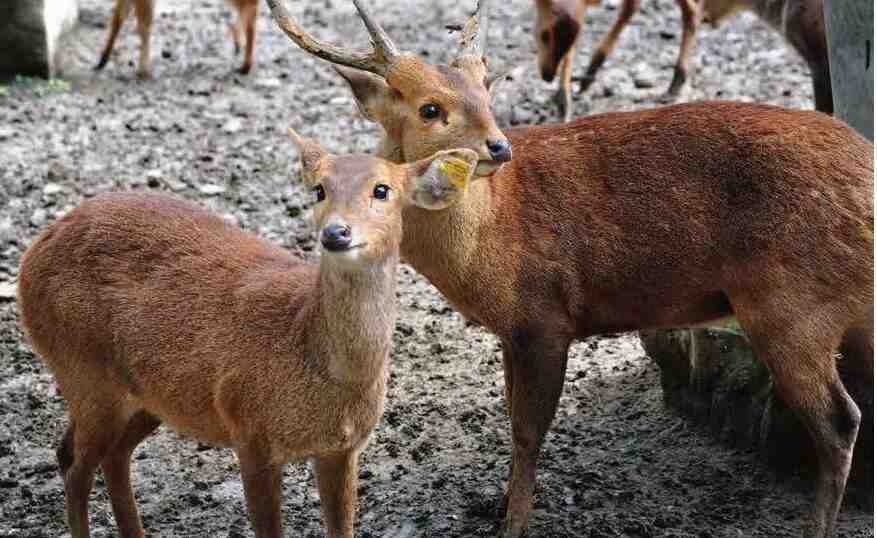Axis porcinus
IUCN
LCBasic Information
Scientific classification
- name:Axis porcinus
- Scientific Name:Axis porcinus, Hog Deer, Indian Hog Deer, Indochina Hog Deer, Indochinese Hog Deer, Thai Hog Deer,Cerf des Marais, Cerf-cochon, Cerf-cochon d'Indochine,Ciervo Porquerizo de Indochina , Indischer
- Outline:Ungulata
- Family:Artiodactyla Ruminantia Cervidae Cervus
Vital signs
- length:66-74cm
- Weight:36-45kg
- lifetime:12-15 years, up to 20 years
Feature
Rare animals that once became extinct in ChinaRare animals that once became extinct in China
Distribution and Habitat
Distributed in Bangladesh, Bhutan, Cambodia, India, Nepal, Pakistan and China; restored population: Thailand; introduced: Australia, Sri Lanka, United States (Maryland). Due to habitat destruction, the population is extremely small, mostly found in Dudhwa National Park and Jaldapara Wildlife Sanctuary in South Asia.
China only has the Indochinese subspecies, which was discovered between 1959 and 1960 and is distributed along the Nanding River in Gengma and Ximeng counties in western Yunnan near the China-Myanmar border.
It mainly lives on the banks of rivers at an altitude of 500-800 meters and nearby swamp wetlands with wormwood and reeds. It rarely enters mountain forests far from the river bank. It likes open habitats, does not enter dense forests, and often enters bushes and agricultural cultivation areas.
Appearance
It has a stout body, short limbs, and a blunt and low buttocks. At first glance, it looks like a pig, so it is called "hog deer". The whole body is light brown, with light brown hair tips on the back and a gray belly. In summer, there are white spots on the body, and the spots on the back are more obvious than those on the sides of the body. There are irregular gray-white spots on both sides of the back. The male deer has slender three-pronged horns, but the entire horn shape is much shorter than that of the water deer. Female hog deer has no horns. The Chinese subspecies of hog deer (Axis porcinus annamiticus) is larger in size, and the summer hair spots are not very obvious. The summer hair is brown-yellow, and the winter hair is light brown or light yellow.
The hog deer has complete postorbital stripes; it has infraorbital glands that can secrete liquid with a special fragrance, which is applied to tree trunks to mark territory; it has scent glands between the hooves an
Details
Hog Deer, also known as Hog Deer in English, has 3 subspecies and is a medium-sized deer.

Hog Deer like to move alone, occasionally 2-3 gather together, but never gather in large groups. However, they often gather in temporary small groups during the rutting season and in feeding areas, with each group ranging from a few to more than 10 individuals. During the day, they hide in the woods and grass, and only come out to forage in the evening. Hog deer can mate and reproduce all year round, and this instinct is conducive to expanding the population. Hog deer have short legs and like to lower their heads when moving, so their movements are not as agile as sika deer.
Hog deer often hide in tall grass or reeds in wetlands during the day, feeding on the stems and leaves of reeds, especially red deer grass, and often forage for tender reeds that regenerate after burning. They also eat reed leaves and other aquatic plants, and steal crops such as soybeans, corn seedlings and melons.
The hog deer is a unique species distributed in the grasslands of the Indo-Gangetic plains. Punjab and Assam in India were the habitats of the hog deer in the past. Due to various threats such as over-harvesting, flooding and invasion of sparse forests, it is now only found in Dudhwa National Park (Uttar Pradesh) and Jaldapara Wildlife Sanctuary (West Bengal).
In China, hog deer were found in southwestern Yunnan (Gengma and Ximeng) in the 1950s and 1960s (horns and skins were purchased). In the Gengma area, it is estimated that there are more than 10 (Peng Hongshou et al., 1962). Three years later, Yang Dehua et al. (1965) surveyed and found only 4. When another survey was conducted in the late 1980s, it had already disappeared in the Gengma area. It is unclear whether there are any remnants in the border area of Ximeng. The main endangered factor is the complete destruction of the habitat. In the mid-to-late 1970s, farms were opened in the Nanding River area of Mengding, completely destroying the habitat of the hog deer, and the hog deer lost the most basic living conditions. In addition, hunting is also a factor that caused the hog deer to become extinct in the wild. The Chinese Red Data Book of Endangered Animals announced that the hog deer is extinct in China. There have been no records of wild hog deer in China since the 1960s. Until 2007, a female fawn that was just a few days old was found in the Daxueshan National Nature Reserve in Yongde, Yunnan. It is now a national first-class protected animal.
China Species Red List Assessment Level: Critically Endangered CRD.
China National Protection Level: First Class National Protection Level Effective Year: 1989.
Listed in the 2012 Red List of Endangered Species of the World Conservation Union (IUCN) ver 3.1 - Endangered (EN).
Listed in the first level of the "List of National Key Protected Wildlife in China".
Protect wildlife and eliminate game.
Maintaining ecological balance is everyone's responsibility!








